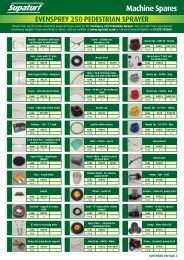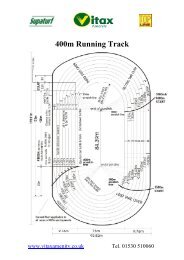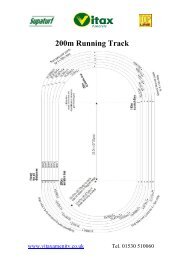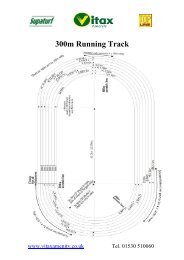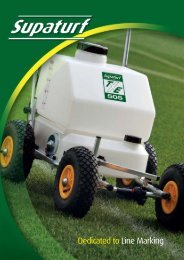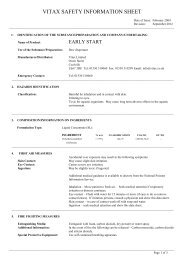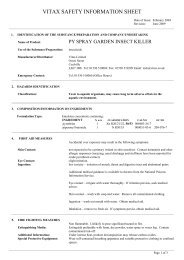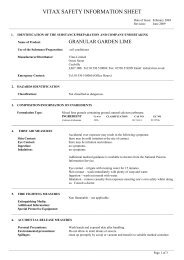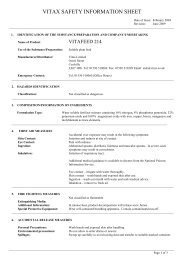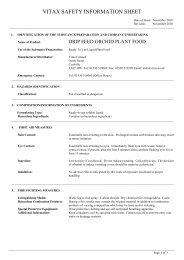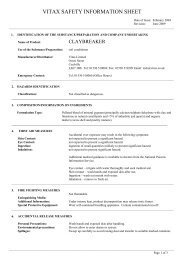New Estermone - Vitax
New Estermone - Vitax
New Estermone - Vitax
Create successful ePaper yourself
Turn your PDF publications into a flip-book with our unique Google optimized e-Paper software.
VITAX SAFETY INFORMATION SHEET<br />
Date of Issue: February 2004<br />
Revision: June 2009<br />
__________________________________________________________________________________________________________<br />
Special Protective Equipment: Wear self-contained breathing apparatus in confined spaces. Contain contaminated<br />
run-off.<br />
________________________________________________________________________________________________________<br />
6. ACCIDENTAL RELEASE MEASURES<br />
Personal Precautions: When dealing with spillage wear protective gloves, boots and overalls. Do not<br />
breathe vapour. Do not eat, drink or smoke. Wash hands and exposed skin after<br />
handling.<br />
Environmental precautions: Report to local water plc immediately if spillage enters drains and the Environment<br />
Agency or Scottish Environment Protective Agency if it enters surface or ground<br />
waters.<br />
Spillages: Soak up with absorbent material such as sand and transfer to suitable marked<br />
container, and keep safe before disposal.<br />
________________________________________________________________________________________________________<br />
7. HANDLING & STORAGE<br />
Handling: Do not block stack pallets.<br />
Storage: Store in original containers, tightly closed in a secure, well ventilated, cool but frostfree,<br />
dry area. Store clear of foodstuffs and in a separate stack from insecticides,<br />
fungicides and fertilisers. Make arrangements for containment of accidental spillage.<br />
_________________________________________________________________________________________________________<br />
8. EXPOSURE CONTROLS/ Occupational exposure standards (EH40) for 2,4-D in air: 10 mg/m 3 (8 hr) 20 mg/m 3<br />
PERSONAL PROTECTION (15 min). OEL recommended for solvent 5 mg/m 3 . Personal protective equipment<br />
recommended where engineering control of operator exposure is impractical:<br />
faceshield, chemical resistant gloves, rubber boots (when applying by hand-held<br />
equipment or clearing spillages) and coveralls.<br />
_______________________________________________________________________________________________________<br />
9. PHYSICAL & CHEMICAL Appearance oily liquid forming emulsion with water<br />
PROPERTIES Autoflammability > 400 deg C<br />
Odour strong aromatic<br />
Boiling point 200-265 deg C (for solvent)<br />
Explosion limits 0.6-6.0% (for solvent)<br />
Flash point > 70 deg C<br />
Flammability combustible<br />
Kinetic viscosity 3.863 x 10 -6 m 2 /s @ 40 deg C<br />
Melting point not determined<br />
Oxidising properties N/A<br />
pH (1%) 4<br />
Relative density 1.01 at 20 deg C<br />
Solubility miscible in water<br />
Surface tension 33.1 mN/m @ 25º deg C<br />
Vapour pressure not determined<br />
Other data none<br />
_____________________________________________________________________________________________________<br />
10. STABILITY & REACTIVITY<br />
Stability: stable under ambient conditions.<br />
Conditions to Avoid: avoid high temperatures - not classified as flammable but will burn if involved in a<br />
fire producing toxic fumes.<br />
Materials to Avoid:<br />
Hazardous Decomposition Products: not classified as flammable but will burn if involved in a fire producing toxic fumes.<br />
__________________________________________________________________________________________________________<br />
Page 2 of 4



